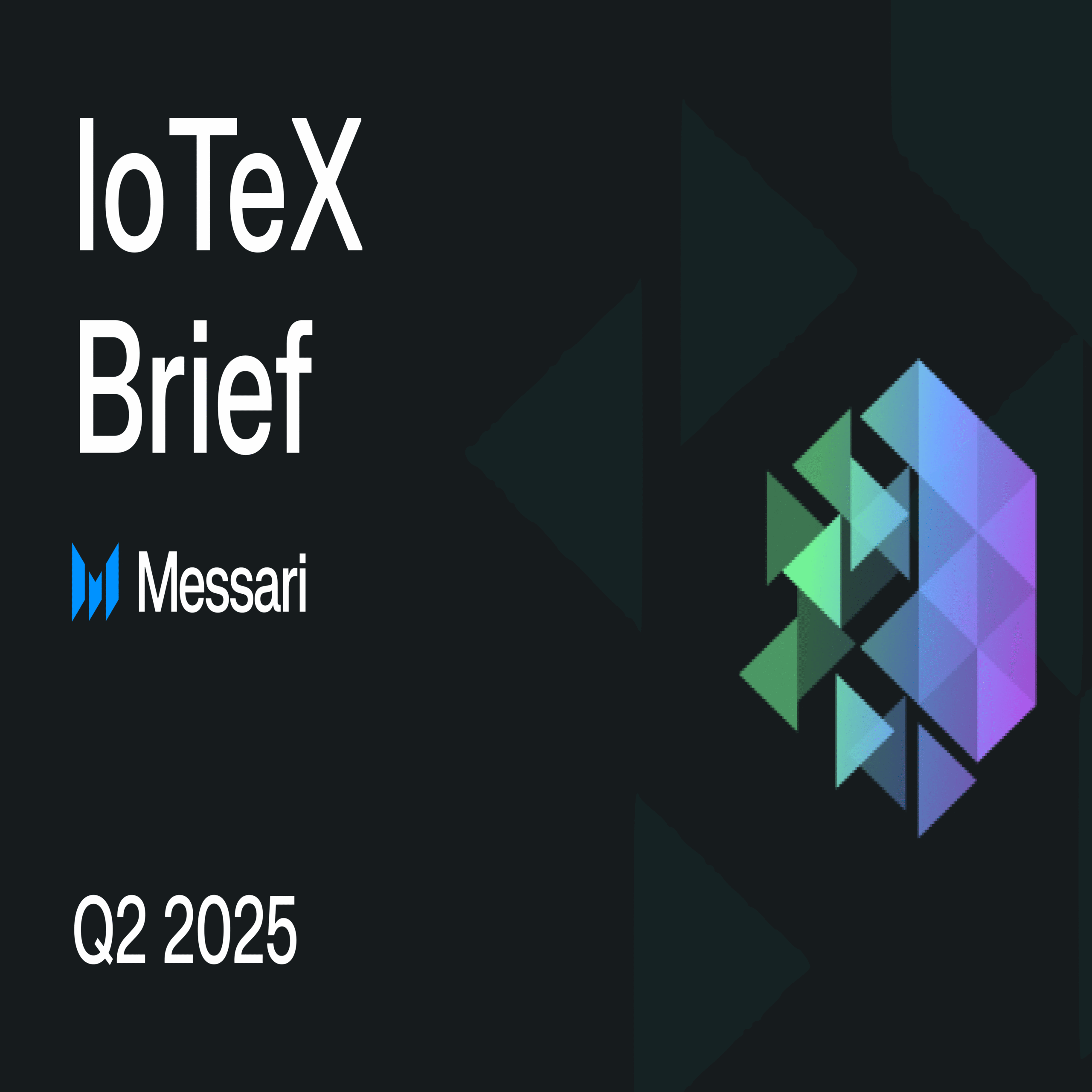Key Insights
- In June, IoTeX launched a beta interface for Quicksilver, a DePIN infrastructure framework that enables AI agents to query, analyze, and respond to decentralized physical data from connected devices. Developers can use the interface to build and deploy agents, while users can query those agents via chat or API.
- On June 19, IoTeX released the v2.2.0 hard fork upgrade, reducing block time from 5s to 2.5s and increasing theoretical throughput to 2,000 transactions per second (TPS).
- In July, IoTeX introduced a roadmap for Realms, a planned system that groups AI agents, data, and contributors into domain-specific ecosystems (e.g., transportation, health, energy) to support structured, context-driven intelligence. IoTeX plans to offer token incentives for contributors, such as device owners and data labelers who supply or contextualize real-world data within each Realm.
- Average daily active wallets declined 26% QoQ to 6,600 but were still up 872% YoY. Likewise, average daily transactions fell 25% QoQ to 222,300 but were still up 750% YoY.
- IoTeX protocol revenue decreased 53% QoQ to $94,800, but was still up 505% YoY. The QoQ fee decline was driven by a 93% drop in ioID activation fees to $6,900, a 17% decrease in gas fees to $46,000, and a 12% decline in DEX fees to $42,000.
Primer
IoTeX (IOTX) is a modular infrastructure platform that supports 130 applications in an open decentralized physical infrastructure networks (DePIN) ecosystem designed to power physical intelligence. The IoTeX network comprises of an EVM-compatible Layer-1 (L1) blockchain, an offchain computing layer that generates validity proofs for data verification (W3bstream), an identity framework for smart devices and AI agents (ioID), and an AI agent development platform (Quicksilver AI) to connect real-world data from devices, machines, and sensors with onchain applications. IoTeX supports integrations with data sequencer and data availability applications, though none are currently integrated with its infrastructure. IoTeX expects third-party projects to integrate these components over time.
Users can stake the IoTeX L1’s native token (IOTX) to vote for one or more community-elected delegates to secure the network, validate transactions, and produce new blocks. IOTX can also be used to pay gas fees on the IoTeX L1. The IoTeX L1 utilizes a Randomized Delegated Proof-of-Stake (Roll-DPoS) consensus mechanism, randomly selecting 24 of the top 36 delegates every hour to secure the network.
Quicksilver is a framework for integrating DePINs with AI agents, enabling them to process physical-world data, respond adaptively, and take AI-driven automated actions. These devices generate continuous data streams that W3bstream verifies before AI agents use them for analysis or task execution.
W3bstream is an offchain computing layer that uses zero-knowledge (ZK) proofs to verify data from DePIN devices and settle proof of real-world activity records onchain. This enables DePIN builders to verify the authenticity of device-generated data. At the core of Quicksilver is ioID, a decentralized identity (DID) module that creates onchain verified identities for hardware devices, such as smart devices and sensors.
BinoAI is IoTeX’s DePIN-oriented AI agent built on Quicksilver. It operates as an expert voice that autonomously posts on X and shares knowledge about DePIN projects. For a full primer on IoTeX, refer to our Initiation of Coverage report.
Network Overview
Usage
More than 130 applications use IoTeX L1 blockspace to track device data and process offchain computations. The real-world data is sourced primarily from smart devices, machines, and sensors.
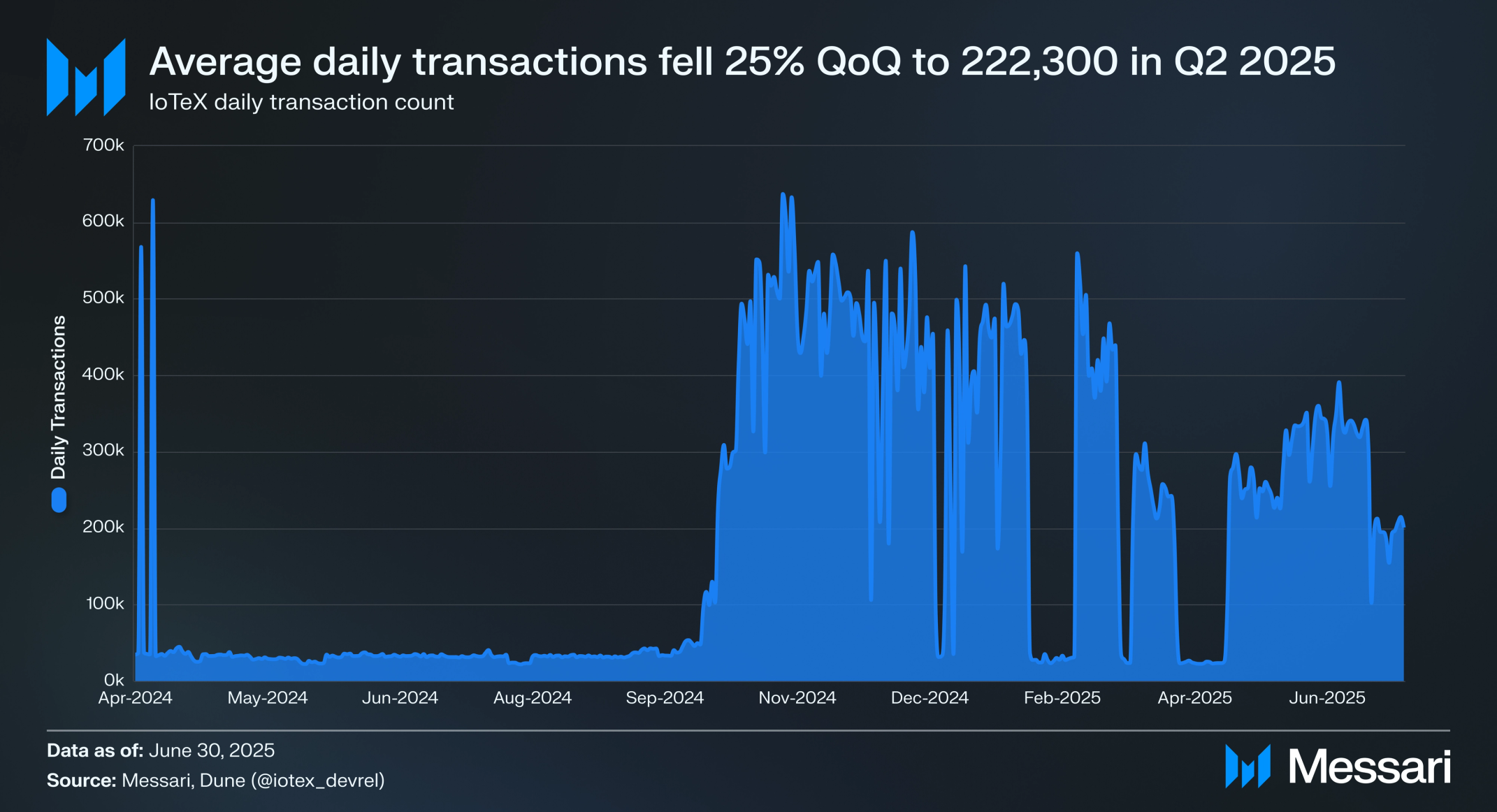
Average daily transactions on the IoTeX L1 fell 25% (74,200 average daily transactions) QoQ from 296,500 to 222,300, but were still up 750% YoY from 26,100 in Q2 2024. The decrease may be attributed to the conclusion of the Get Goated Season 2 on Jan. 29, which incentivized users to participate in DeFi and DePIN-related tasks across selected protocols by completing tasks to earn rewards. Get Goated Season 2 included a 100 million IOTX token reward pool and $2 million in contributions from over 15 DePIN projects.
Despite the QoQ decrease, average daily transactions are up 690% (196,200 average daily transactions) YoY from 26,100 in Q2 2024. That increase stems from a Q3 2024 spike in usage following the launch of ioID, an onchain identity framework for smart devices. Some regression was expected after that surge, but network usage on IoTeX L1 has remained elevated across the last three quarters.
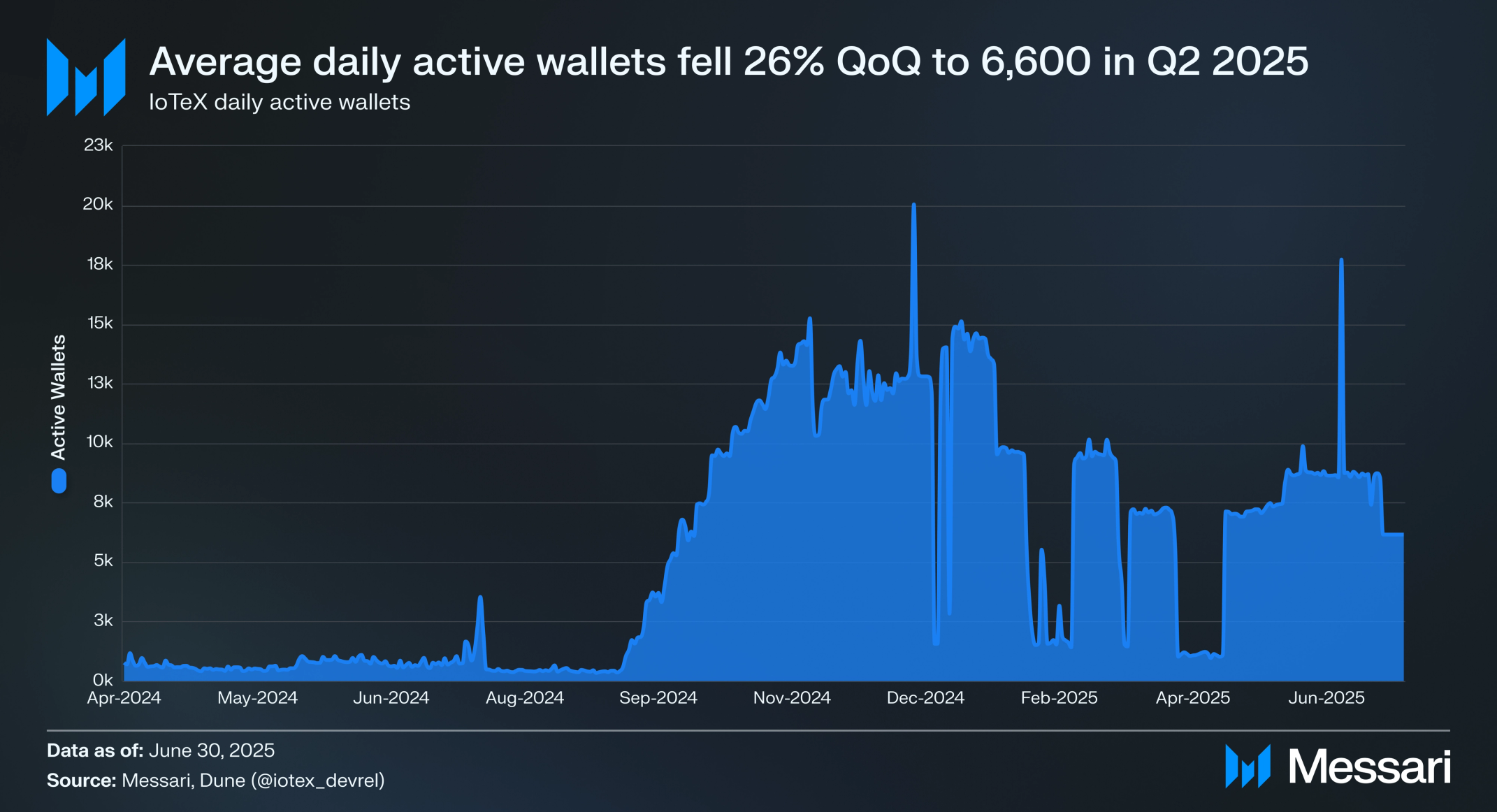
Average daily active wallets on the IoTeX L1 fell 26% (2,300 daily active wallets) QoQ from 8,900 to 6,600. This pullback mirrors the post-Get Goated Season 2 decline in average daily transactions. Once the 100 million-IOTX reward pool expired and the Mar. 27 claim window closed, some incentive-driven wallets went dormant. Even after the slowdown, average daily active wallets remain far higher than pre-ioID levels established in 2024, up 872% YoY from 700 in Q2 2024.
Staking Overview
IOTX is the native token used to pay transaction fees on the IoTeX L1 blockchain. Holders can stake IOTX and subsequently vote for delegates who secure the network, validate transactions, and produce new blocks. Stakers and delegates earn IOTX rewards in return for their services and capital.
Additionally, the ioID module requires IOTX tokens to be burned to create new onchain identities for devices, resulting in a dynamic burn rate based on the total number of new device registrations. Burning IOTX is also required for other actions in the ioID module, such as obtaining verifiable credentials (VCs) for decentralized identification (DIDs) and linking device identities to the IoTeX L1.
In 2019, IoTeX allocated 12% of the total IOTX supply (1.2 billion IOTX) for staking rewards, but this allocation became nearly exhausted. In November 2024, IoTeX 2.0 introduced inflationary staking rewards, minting new IOTX to distribute to delegates and stakers involved in network consensus. The annual inflation rate is determined by network-wide governance within a targeted range (6-11% APR staking rewards).
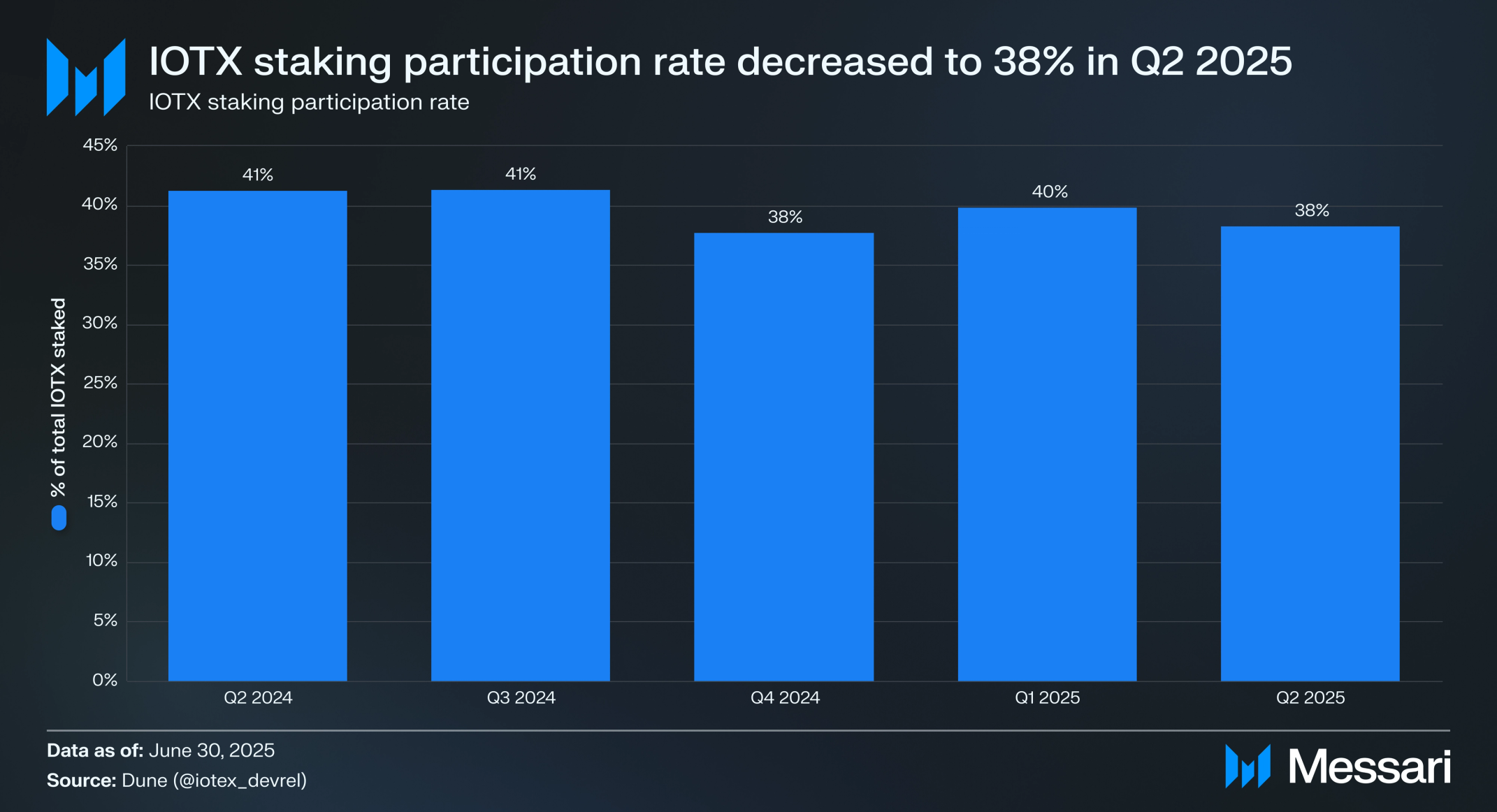
At Q2 close, 121 active delegates secured the IoTeX L1 blockchain. 3.6 billion IOTX (38% of the circulating supply or $75 million) were staked, a 2% (151 million IOTX) decrease QoQ.
ioID
In November 2024, IoTeX announced the release of ioID, an onchain identity framework for smart devices. The core components of the ioID architecture are ioID identifiers, device NFTs, Machine-Bound Accounts (MBAs), and an ioID registry.
An ioID identifier is a decentralized identifier (DID) that lets Internet of Things (IoT) devices, individuals, or organizations create unique blockchain-based identities. Each ioID identifier is formatted as did:io:
Each ioID identifier links to a DID document, which is a JSON-LD metadata file (encoded structured data on web pages) stored on the InterPlanetary File System (IPFS, a blockchain-based data storage protocol), that defines the device owner’s wallet address, the device’s authentication settings, and what services or projects it belongs to.
A device NFT is an ERC-721 token that is the onchain representation of a physical machine. It forms a link between tangible assets and their ioID identifier onchain. Each device NFT enables onchain registration of new physical assets, tracks ownership transfers, and access control via smart contracts. Manufacturers or operators mint device NFTs when the asset first enters operation. For example, minting might occur when a drone or IoT sensor is manufactured, or when provisioning a new node in a DePIN network. Minting marks the exact moment a physical asset becomes verifiable and functional onchain, ready to interact with reward systems, staking protocols, or AI networks. Device owners pay IOTX to activate an ioID, and once activation completes, the minted Device NFT records onchain ownership of the device.
MBAs are smart contract wallets that are permanently linked to a device’s NFT using the ERC-6551 standard. MBAs let devices interact with applications, services, and other devices without continuous human oversight. Each MBA is automatically generated from a device’s unique ID (i.e., serial number, IMEI) when a DePIN project registers an ioID identifier for a device onchain. Ownership of an MBA transfers automatically with its linked NFT.
The ioID registry is a smart contract on the IoTeX L1 that maps each device to its device NFT, owner wallet, and MBA, allowing contracts and offchain services to determine device ownership and associated MBAs tied to device NFTs.
The ioID suite works in tandem with W3bstream, a verifiable compute layer that validates device activity and data in the DePIN ecosystem. W3bstream applies zero-knowledge (ZK) proofs to verify device data before settling it onchain.
ioID is designed to provide a universal onchain registry for machines collecting real-world data, support MBA-based DeFi participation, enable autonomous M2M communication, and verify offchain device data.
For example, consider a smart air-quality sensor deployed in a city. When manufactured, the sensor’s ioID identifier is registered on IoTeX, and it receives a device NFT as its digital identity. This NFT connects directly to an MBA, a digital wallet specifically for that sensor. The sensor can automatically send verified air-quality data to a city dashboard and receive token payments directly into its MBA. The ioID identifier leverages the W3bstream module to verify that the data originated from that specific, trusted sensor. Earned tokens and rewards remain in the MBA, permanently linked to the sensor even if ownership changes.
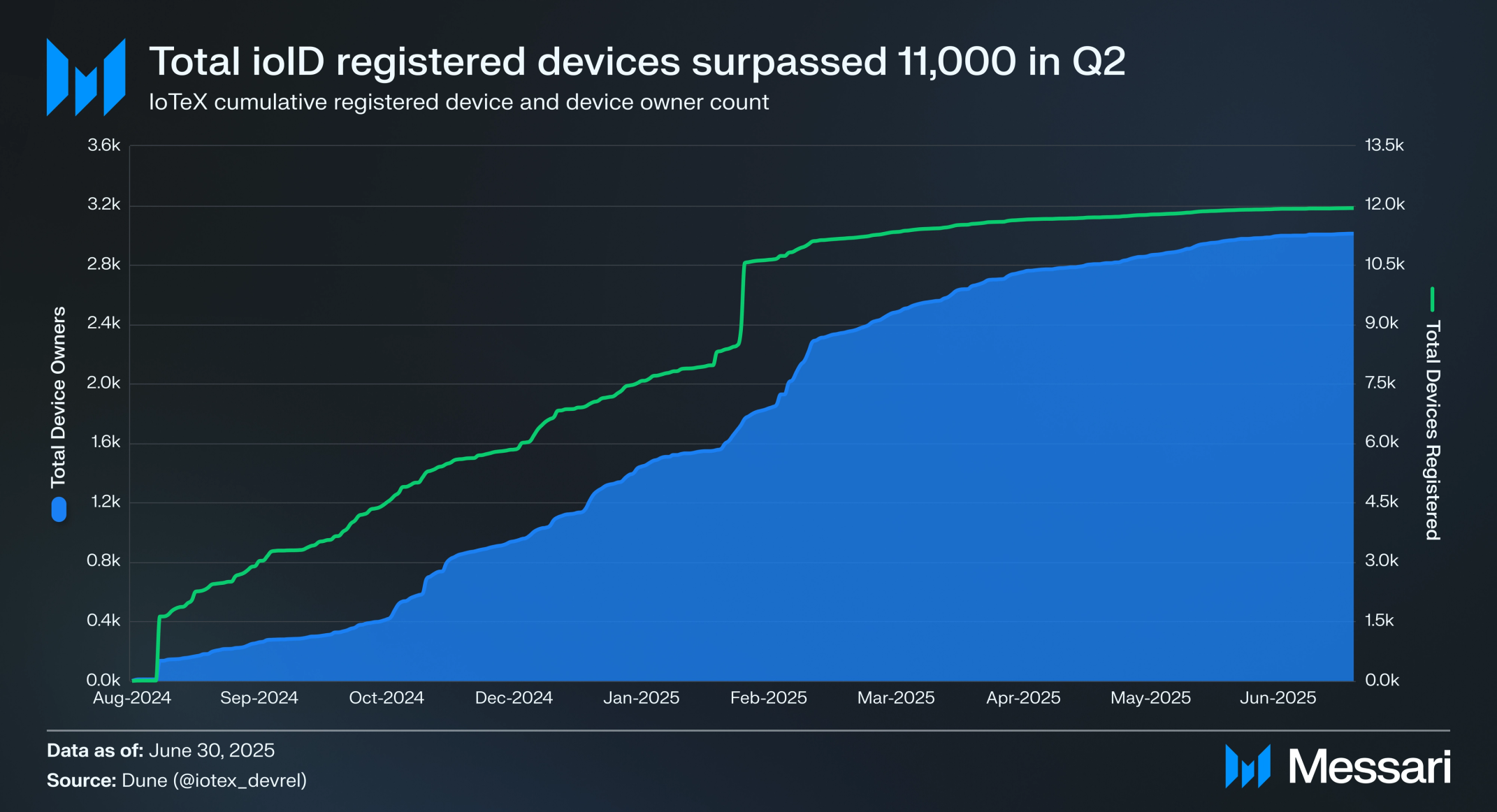
ioID device owners increased 11% QoQ from 2,700 to 3,010, while new ioID devices registered increased only 3% QoQ from 11,500 to 11,900. This marks a slowdown in adoption following strong Q1 growth, when ioID device owners rose 93% QoQ from 1,400 on Dec. 31, 2024, to 2,700 on Mar. 31, 2025, and registered devices increased 54% QoQ from 7,500 to 11,500 over the same period. The Q2 decline stems from a reduction in device registration of Network3, an AI platform where users supply bandwidth, IP, data, and compute power for token rewards.. As of June 30, Network3 held an 80% market share of ioID-registered devices (9,150 devices).
Financial Overview
Fees
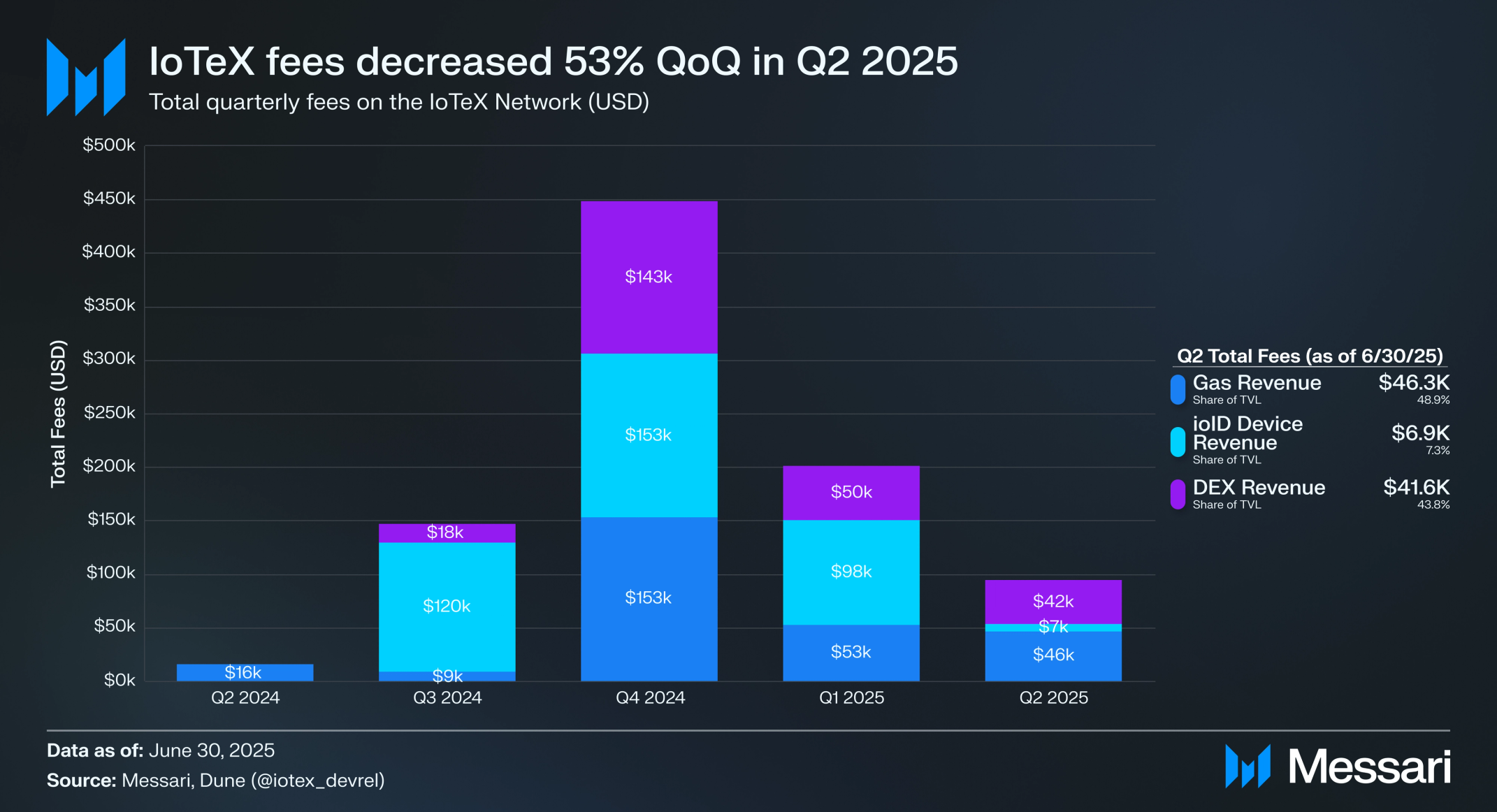
Protocol revenue for the IoTeX network comes from three IOTX-denominated fees: gas fees, ioID device-activation fees, and decentralized exchange (DEX) fees. Gas fees are paid by anyone initiating a transaction on the IoTeX L1 blockchain, similar to Ethereum’s transaction fee structure. ioID activation fees apply when registering a new device. DEX fees come from trades on Mimo, the leading DEX by TVL on IoTeX, which in 2024 launched the DePIN Liquidity Hub to let users trade DePIN tokens bridged from Solana, Ethereum, Polygon, and other chains.
In Q2, protocol revenue fell to $94,800 (4.8 million IOTX), a 53% QoQ decrease in USD terms (37% QoQ decrease in IOTX). This reduction stemmed from the 93% QoQ decrease in ioID device activation revenue from $97,900 (5.6 million IOTX) to $6,900 (400,000 IOTX).
Gas revenue and DEX revenue had moderate declines, as gas revenue decreased 17% QoQ from $53,000 (2.1 million IOTX) to $46,000 (2.3 million IOTX), while DEX revenue decreased 12% QoQ from $50,000 (2.1 million IOTX) to $42,000 (2.0 million IOTX).
Qualitative Analysis & Key Developments
Quicksilver Beta Launch and AI Agent Ecosystem
In January 2025, IoTeX introduced Quicksilver, a modular, open-source framework for building AI agents. In June, IoTeX launched the Quicksilver AI interface (beta), enabling developers to configure agent personality, logic, and API access, set pricing to monetize usage, and let users query those agents via chat or API using DePIN data.
Users can either interact directly with an agent-specific chat or use the global chat. Direct interactions return responses using only that agent’s data and logic. In the global chat, Quicksilver’s sentient AI “core orchestrator” acts as a coordinating AI layer, selecting the most relevant agents and APIs for each query and returning a response derived from their combined outputs.
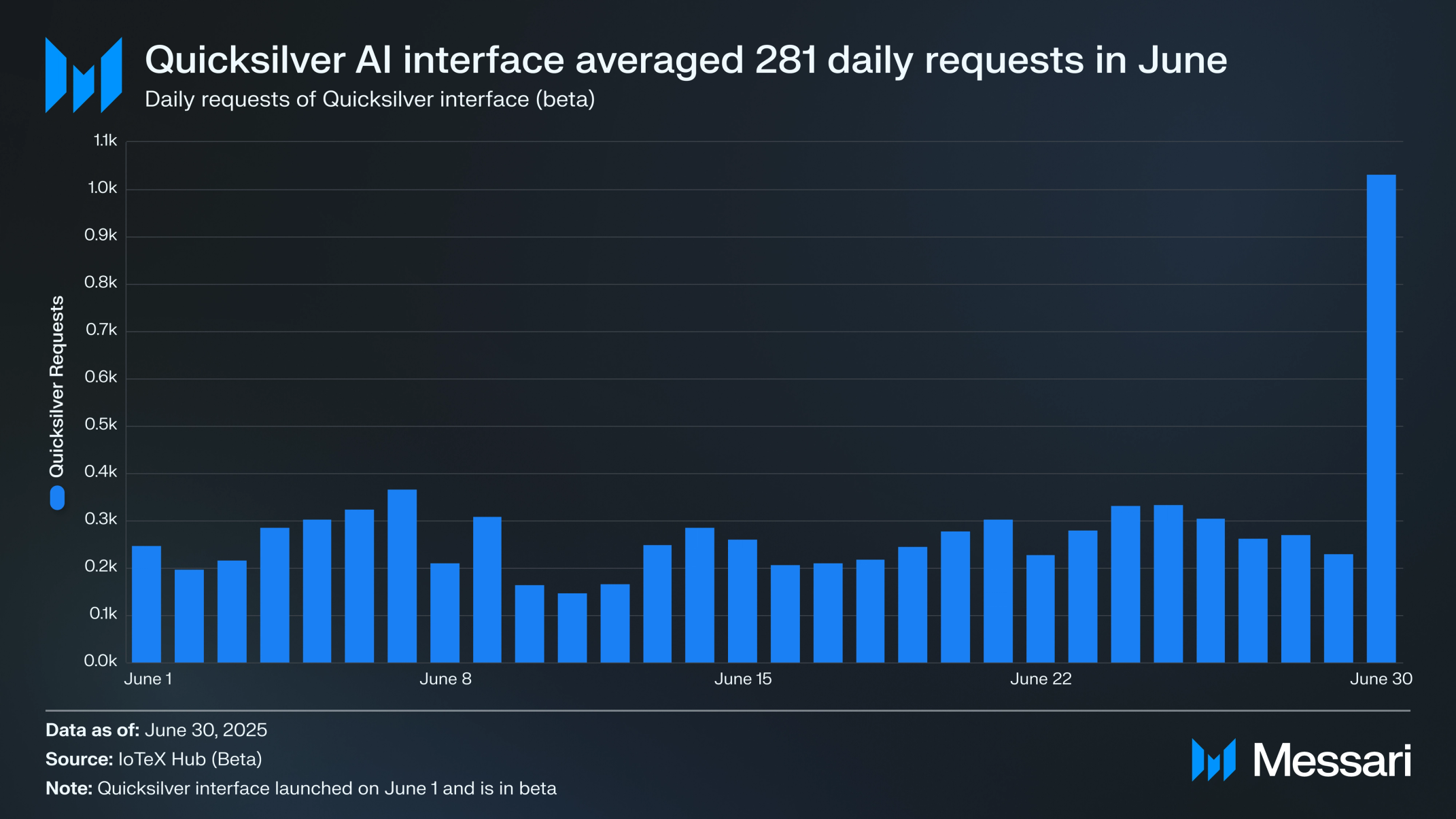
The Quicksilver AI interface averaged 281 daily requests in June. Activity climbed 43% over the month, rising from a 276 daily average in the first week (June 1–7) to 394 in the final week (June 24–30). Quicksilver agents process user prompts using LLM integrations with OpenAI (GPT-4o-mini), Anthropic (Claude 3.5 Haiku), and DeepSeek, pull data from APIs, blockchains, and DePIN networks, and execute actions such as sending transactions, posting to social platforms, or calling services.
Quicksilver already integrates with Messari Copilot (research), DePIN Ninja (analytics), DefiLlama (protocol data), Nubila (weather), and CoinMarketCap (pricing data), with additional tools planned.
DePIN Agent and Weather Agent are examples of early-stage agents built in Q2 and available through the interface. DePIN Agent is designed to answer blockchain-related questions and provide insight into DePIN projects using data from protocols on the IoTeX L1 network. Weather Agent retrieves real-time and historical environmental data, such as temperature, humidity, and precipitation, sourced from networks like Nubila. Both agents are accessible through the beta interface and remain in development.
In June 2025, IoTeX announced the release of Nodey AI from the Impossible Cloud Network (ICN), a social AI agent powered by Quicksilver. Nodey interacts with users on X and Discord, answering questions about cloud-network node operations and staking. It pulls live data from the ICN protocol, which provides decentralized cloud storage solutions.
The expanded capabilities and usability of Quicksilver in Q2 have positioned IoTeX to attract further developer engagement and user adoption across DePIN and AI domains.
IoTeX Layer 1 Updates
On June 3, IoTeX announced the integration of IOTX on Solana through Wormhole’s Native Token Transfer (NTT) framework. The update allows users to transfer IOTX between Ethereum and Solana, expanding the token’s interoperability across chains. This integration opens new pathways for IoTeX-based DePIN and AI services to interact with Solana applications.
On June 19, IoTeX released the v2.2.0 hard fork, requiring all nodes to upgrade to maintain network compatibility. The update reduced the block interval from 5 seconds to 2.5 seconds, doubling the block production rate and increasing the maximum theoretical throughput to 2,000 transactions per second (TPS). The shorter block interval supports latency-sensitive use cases, including onchain AI agents and DePIN applications that need rapid finality. The upgrade also deployed System Staking Contract Version 3, which replaced the deprecated Version 2. The IoTeX L1 had a Nakamoto coefficient of nine as of June 30.
Realms and AI Infrastructure Roadmap
In July 2025, IoTeX announced a roadmap to develop an open ecosystem for AI infrastructure built using physical intelligence. The future architecture is centered around enabling AI agents to process verified data from DePINs, with the goal of supporting context-aware AI applications across sectors such as mobility, robotics, energy, and healthcare.
IoTeX aims to position its stack at the center of a data loop where DePINs supply data, IoTeX verifies and contextualizes it, and AI agents consume the output. In the proposed roadmap, the IoTeX L1 blockchain will verify real-world signals onchain, ioID will authenticate the onchain identity of machines and agents, Quicksilver will validate incoming DePIN data and structure it into an AI-readable context, and AI agents built on Quicksilver will train and act on real-time feedback.
IoTeX’s roadmap also outlines a planned system called Realms, which are industry-specific knowledge bases that group data, agents, and contributors around specific domains such as road conditions, health statistics, or energy output.
For example, in a transportation Realm, vehicles would stream diagnostics, location, and traffic data. Quicksilver would verify the input, while domain specialists add context by tagging variables like vehicle type, time of day, or weather conditions, or by simulating scenarios such as congestion or accident response. AI agents could use the resulting dataset to optimize routes, train autonomous systems, or detect incidents.
Each Realm is expected to use a token incentive model in which contributors earn rewards for the value of their data, and AI applications pay IOTX to query the datasets. Contributors include device owners and data labelers, reinforcing dataset quality over time through sustained use.
IoTeX is positioning Realms as the foundation for a future data economy. The system and broader infrastructure are still in development and have not been launched as of Q2 2025.
Closing Summary
In Q2 2025, IoTeX activity decreased for the second consecutive quarter as average daily transactions fell 25% QoQ from 296,500 to 222,300, and average daily active wallets declined 26% QoQ from 8,900 to 6,600. Total fees for the protocol decreased 53% QoQ to $94,800, driven by a 93% drop in ioID activation fees to $6,900, a 17% decline in gas fees to $46,000, and a 12% reduction in DEX fees to $42,000. 121 active delegates staked 3.6 billion IOTX (38% of the circulating supply or $75 million), a 2% (151 million IOTX) decrease QoQ.
Despite lower activity, IoTeX expanded its infrastructure in Q2 by launching the Quicksilver AI interface (beta). The Quicksilver interface enables developers to build and users to interact with AI agents using live DePIN data. IoTeX unveiled an AI-infrastructure roadmap featuring Realms, planned domain-specific datasets for context-aware AI. IoTeX L1 upgraded to v2.2, which halved block time to 2.5 seconds, and increased the theoretical throughput to 2,000 TPS. While ioID device registration slowed in Q2, the protocol continues to evolve across DePIN, identity, and AI verticals.
Let us know what you loved about the report, what may be missing, or share any other feedback by filling out this short form. All responses are subject to our Privacy Policy and Terms of Service.
This report was commissioned by MachineFi. All content was produced independently by the author(s) and does not necessarily reflect the opinions of Messari, Inc. or the organization that requested the report. The commissioning organization may have input on the content of the report, but Messari maintains editorial control over the final report to retain data accuracy and objectivity. Author(s) may hold cryptocurrencies named in this report. This report is meant for informational purposes only. It is not meant to serve as investment advice. You should conduct your own research and consult an independent financial, tax, or legal advisor before making any investment decisions. Past performance of any asset is not indicative of future results. Please see our Terms of Service for more information.
No part of this report may be (a) copied, photocopied, duplicated in any form by any means or (b) redistributed without the prior written consent of Messari®.
